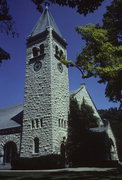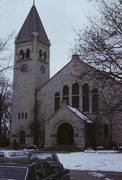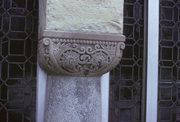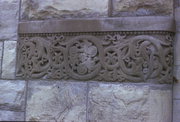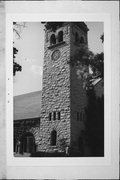| Additional Information: | A 'site file' exists for this property named 'Beloit College'. It contains additional information such as correspondence, newspaper clippings, or historical information. It is a public record and may be viewed in person at the Wisconsin Historical Society, State Historic Preservation Office.
Built of rusticated stone in the massive Richardsonian Romanesque manner, Eaton Chapel is the finest example of its style in Beloit, and a distinguished landmark on the Beloit College Campus. Designed by the Chicago architectural firm of Patton and Fisher, Eaton Hall is characterized by a battered bell tower, with arcaded bellfry and giant clock face, by an arcade of round arches, with radiating stone voussoirs, on the ground level of the south facade, and by a gabled east entry porch. All the exterior load bearing walls are constructed of massive and heavily rusticated limestone blocks, which provides visual interest to the otherwise unadorned structure.
The chapel was refurbished in 1937-38, under the direction of architect Maurice Webster, a brother of Josephone Webster Strong (M5s. Walter Ansel Strong). The structure was lengthened by the addition of 50 feet to the west, embracing an apse, a chancel and a choir. A large arch blends the apse to the chancel. The exterior roof line of the chapel was extended over the chancel; within, it joined with the new arch, and upon the merger the roof contour was altered. Panels, possible masonite, were superimposed upon the tongue and groove ceiling for better acoustics; they were decorated with a series of Byzantine-style paintings depicting the iconography of the early Christian church.
Further alteration was required following the disastrous fire in december, 1953. Webster again was the architect for the rebuilding. Undamaged portions of the chapel were integral to this rebuilding. The bearing walls were structurally sound and rebuilding proceeded incorporating some of them into the new interior. The roof and ceiling were replaced, a balcony (extant in the first chapel only on the east wall) was extended on three sides. The heavy, but fake Norman columns of the interior were also destroyed. The arched porch to the south was incorporated into the main auditorium. The rebuilding was completed in less than a year.
None of these alterations or additions have altered the essential character of the exterior rusticated stonework, the great battered tower, with its arcaded openings and clock faces, the east entry porch and the south arcade remain intact. In its massing and rigorous texture the building is clearly in the Richardsonian tradition and would be considered an outstanding landmark in any setting.
Norman S. Patton (1852-1915), the architect, attended Beloit College, Amherst and MIT, from which he graduated in architecture in 1874. The first of three successive partnerships in which he practiced, Patton and Fisher, also designed Emerson Hall (c.f., 1897-1898, NRHP, 1979); his third partnership, Patton and Miller, designed both the Smith Gymnasium (1903-1904), now the Student Union (c.f.), and the Carnegie Library (1903-1905), now the Pettibone World Affairs Center (c.f.).
The cornerstone of the college chapel was laid in April, 1891. Services moved from Old Chapel (now South College) and remained there until the 1970s when religious services faded from the scene; the present use is primarily as an auditorium for college events and serves as the Beloit home of the Beloit/Janesville Symphony.
By 1937, the chapel could no longer accomodate the size of the student body and a major remodeling was begun. The chapel had been renamed in 1930 in honor of Beloit College's second president, Edward Dwight Eaton, and has since been referred to as Eaton Chapel.
Following an arson-set fire in 1953, the chapel was rebuit, and competed in time to serve as the scene of the inauguration of Miller Upton as the sixth president. Formal rededication took place one year after the fire, on December 12, 1954, with F.S.C. Northup as the main speaker. |
|---|
| Bibliographic References: | (A) Historical Sites and Points of Interest in Rock County, Wisconsin, Rock County Tourism Council 5/1994.
(B) R.H. Irmann, "Data on Beloit College Bulidings," on file at Archives of Rock County Historical Society.
(C) National Register of Histroic Places, Inventory--Nomination form, 1979, for Emerson Hall. |
|---|

